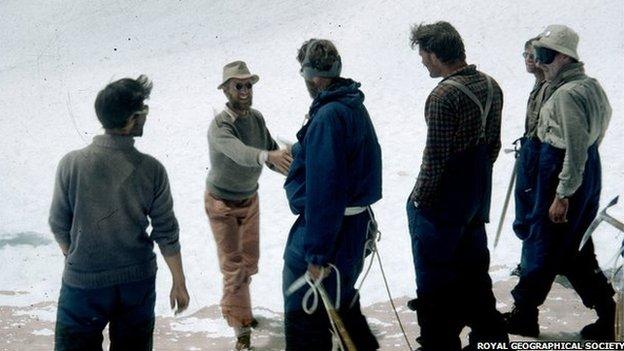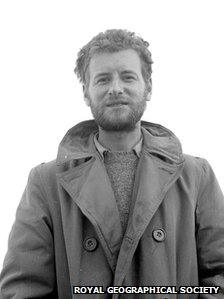The press battle to report Everest climb
- Published

Morris (second left), seen here congratulating Hillary after his climb, managed to get the news back from Everest to London in secret
Sixty years after the first successful ascent of Mount Everest the reporter embedded with the team responsible for that historic feat has recalled her part in breaking the news to the waiting world.
On Friday 29 May, 1953, at 11:30 local time, New Zealand climber Edmund Hillary and Nepalese Sherpa Tenzing Norgay of the British Mount Everest Expedition, led by Col John Hunt, set foot on the highest point on Earth.
With perfect timing, on the morning of Tuesday 2 June, the day of the coronation in London of Queen Elizabeth II, The Times newspaper published its correspondent James Morris's dispatch from the mountain describing the expedition's success.
In today's world, with the latest satellite technology, it is easy to forget just how much agility - both physical and mental - would have been involved in such a scoop.
For James, now Jan Morris, the only journalist embedded with the expedition, it meant a hazardous descent in fading light from an altitude of 22,000 ft (6,700 m) on the mountain.
A coded message then had to be sent by runner more than 20 miles (32km) to Namche Bazaar, transmitted by radio to Kathmandu and telegraphed from there to the UK.
And, of course, all this to be done to a tight deadline without alerting other news media in the area to the scoop.
'Dash down the mountain'
"You weren't allowed to use a radio so I had to organise runners to take my dispatches back to Kathmandu," recalls Morris in the BBC Radio 3's Sunday Feature programme, Jan Morris - Travels Round My House.
"It was rather romantic, really, because (of) the dash down the mountain with the news from Camp Four above the icefall."
Morris, 86, who has lived for many years in Gwynedd, north Wales, received the news of Hillary and Tenzing's achievement in the early afternoon of Saturday 30 May.
"I had to get down that evening to get the thing away," she tells presenter Anthony Sattin.
"Anyway it was getting dark, you know, and I was going to go down by myself but [expedition member] Mike Westmacott... said it would be crazy and he would come with me.
"And it was very nasty and the icefall was beginning to melt and I was hopeless, I kept falling over.
"Halfway down I said: 'Oh, you go ahead, Mike, I'm not going to go any further. I'll stay here for a bit' and he just said: 'Don't be ridiculous'.
'On top of the world'
"I guess I would certainly have died. I'm sure. And we went on down together through the developing dusk and nightfall, on down to the camp with the news that only I knew.
"I had to get it through to London. The excitement of it. The romance of it. The Queen was going to be crowned. Can you imagine it all?
"Everyone was expecting the news that the Empire was on top of the world."

The expedition's return to London on 3 July 1953, just a month after Morris's (partially hidden, second from right) coded dispatch
According to Morris the famous dispatch read: "Snow conditions bad. Advance base abandoned yesterday. Awaiting improvement. All well!"
"That's what it actually said but it isn't what it meant," she explains. "It meant that Ed Hillary and Tenzing had got to the top of Everest and we were all well."
Despite all the effort needed to get the news back to The Times, its 'Everest Climbed' headline was not splashed across the front page in the way in which it would be today.
Morris, who went on to have a much-celebrated career as a travel writer and also had a sex-change operation, explains: "They didn't have news on the front page then. It was all ads on the front page so they just put a little thing in the top right corner.

James Morris served in World War II and also reported on Suez in 1956
"It went in the press on the very day of the Queen's coronation and everybody cheered."
Col Hunt's 1953 expedition had close links with north Wales, as did several British Everest expeditions before it.
The group used the Pen-y-Gwryd Hotel, at the foot of Snowdon at Nant Gwynant, as a training base, and returned there for decades afterwards to celebrate anniversaries of the climb.
The last surviving climber from the 1953 expedition, New Zealand-born George Lowe, died in Derbyshire aged 89 in March this year.
The Royal Geographical Society is currently running two London exhibitions commemorating the anniversary of the 1953 climb.
Innovation Everest (7 May - 14 June at the Royal Geographical Society) examines the technologies used in the 1953 expedition, while Everest 1953 (23 May - 9 June at the Oxo Gallery) is a photographic exhibition and fine art sale.
- Published29 May 2013
- Published28 May 2013
- Published22 March 2013
- Published22 June 2012
- Published3 August 2010